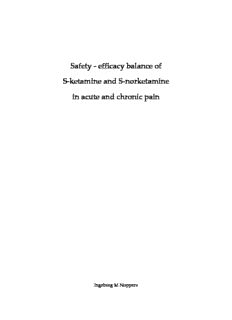
efficacy balance of S-ketamine and S-norketamine in acute and chronic pain PDF
Preview efficacy balance of S-ketamine and S-norketamine in acute and chronic pain
Safety ‐ efficacy balance of S‐ketamine and S‐norketamine in acute and chronic pain Ingeborg M Noppers The studies described in this thesis were performed at the Department of Anesthesiology of the Leiden University Medical Center, Leiden, The Netherlands. This PhD project was performed within TREND (Trauma RElated Neuronal Dysfunction), a Dutch Consortium that integrates research on epidemiology, assessment technology, pharmacotherapeutics, biomarkers and genetics on Complex Regional Pain Syndrome type 1. The consortium aims to develop concepts on disease mechanisms that occur in response to tissue injury, its assessment and treatment. TREND is supported by a government grant (BSIK03016). Copyright: © 2011, IM Noppers, Leiden, The Netherlands. All rights reserved. No part of this thesis may be reproduced or transmitted in any form or by any means, without prior written permission by the author. Photo cover by R ter Voort Layout by AA Vletter Printed by GVO drukkers & Vormgevers B.V. | Ponsen & Looijen, Ede ISBN: 978‐90‐817667‐0‐8 The printing of this thesis was financially supported by the Department of Anesthesiology of the Leiden University Medical Center, Leiden, The Netherlands. Safety ‐ efficacy balance of S‐ketamine and S‐norketamine in acute and chronic pain Proefschrift ter verkrijging van de graad van Doctor aan de Universiteit Leiden, op gezag van Rector Magnificus prof. mr. P.F. van der Heijden, volgens het besluit van het College van Promoties te verdedigen op woensdag 7 september 2011 klokke 15:00 uur door Ingeborg Marieke Noppers geboren te Emmen in 1981 Promotiecommissie: Promotor: Prof. dr. A Dahan Co‐promotor: Dr. EY Sarton Overige leden: Prof. dr. LPHJ Aarts Prof. dr. JG Bovill Prof. dr. M van Kleef (Universiteit Maastricht) Dr. J Marinus Dr. J Vuyk So long as men can breathe or eyes can see, So long lives this and this gives life to thee. William Shakespeare, from Sonnet 18, 1609 Voor mijn ouders Contents Chapter 1 Introduction 9 Chapter 2 Ketamine for the treatment of chronic non‐cancer pain 15 Chapter 3 Drug‐induced liver injury following a repeated course of 35 ketamine treatment for chronic pain in CRPS type 1 patients: A report of 3 cases Chapter 4 Absence of long‐term analgesic effect from a short‐term 49 S‐ketamine infusion on fibromyalgia pain: A randomized, prospective, double blind, active placebo‐controlled trial Chapter 5 Effect of rifampicin on S‐ketamine and S‐norketamine plas‐ 67 ma concentrations in healthy volunteers after intravenous S‐ketamine administration Chapter 6 Negative contribution of norketamine to ketamine‐induced 87 acute pain relief but not neurocognitive impairment in healthy volunteers Chapter 7 Summary, conclusions and future perspectives 109 Chapter 8 Samenvatting, conclusies en toekomstperspectieven 117 Curriculum Vitae 125 List of publications 127 Chapter 1 Introduction Introduction Ketamine ‐ the tiger still roars1 Ketamine, 2‐(2‐chlorophenyl)‐2‐(methylamino)‐cyclohexanone, was first de‐ veloped in 1962 as an alternative to phencyclidine, and first used as an anesthetic in humans in 1964. Phencyclidine produced an anesthetic state coupled to a prolonged emergence delirium (a “centrally‐mediated sensory deprivation syndrome” which resembles some of the symptoms of schizophrenia).1 Ketamine produces a so‐called dissociative anesthetic state in which the patient is dissociated from their surroundings, and although it also causes an emergence reaction, the symptoms are less severe than those produced by phencyclidine. Both drugs have effects at multiple receptor systems, but their main effect is blockade of the N‐methyl‐D‐aspartate receptor (NMDAR), an excitatory ionotropic glutamate receptor present in the spinal cord and brain. Ketamine is considered a ‘safe’ anesthetic, as it is not associated with profound respiratory depression or hypotension; however, when anesthetics that caused fewer or no emergence reactions became available, the use of ketamine as an anesthetic declined and became restricted to specific indications, e.g. patients with severe hypotension or trauma. Numerous studies in volunteers and patients have shown that apart from its anesthetic action, ketamine produces potent analgesia at subanesthetic plasma concentrations (Chapter 2 of this thesis). Anesthesiologists and pain physicians make use of this by combining opioids and ketamine to reduce opioid consumption and improve the quality of pain relief in patients after surgery. These observations led to a significant expansion of ketamine’s use as an analgesic in chronic (neuropathic) pain patients and ketamine began a second life as an analgesic. Because the evidence that ketamine is efficacious in these patients is limited (Chapter 2 of this thesis), studies are still conducted to establish efficacy and improve administration strategies in a variety of chronic pain conditions (Chapters 3 and 4 of this thesis). For ketamine it is obvious that it produces pain relief during intravenous infusion, but its effect following infusion is dependent on the duration of infusion and long‐term infusions are probably required to cause long‐term analgesic effects (Chapter 2 of this thesis). The use of drugs outside of their initial indication (so‐called off‐label use), in this case the use of ketamine for analgesia, raises important questions, not only regarding efficacy, but also regarding short‐term and long‐term safety. This is especially relevant when the mode of administration changes from single or short‐term infusions for induction of anesthesia to long‐term and/or repeated administration for treatment of chronic pain. 10
Description: